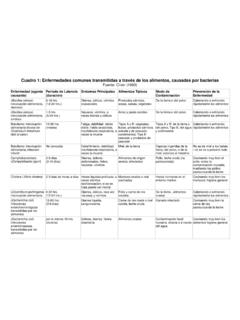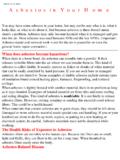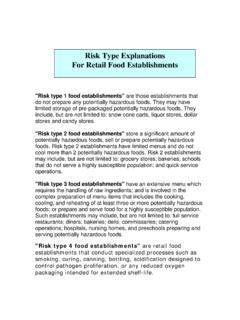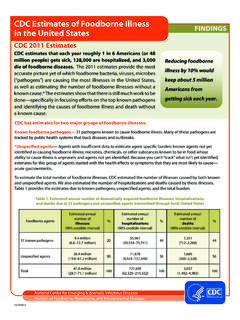Transcription of A Guide to Safe & Healthy Food Handling for Food ...
1 food Handler s Manual A Guide to safe & Healthy food Handling for food Establishments Vineland Health Department 640 E. Wood St. Vineland, NJ 08363-1508 (856)-794-4131 (Adapted from Boulder County Public Health, Boulder, Colorado) food Handler s Manual 2 Table of Contents 3 Responsibilities of the operator and person in 4 Why Proper food Handling is 5 Temperature Controls (hot-holding, cold-holding, cooking temperatures).. 6 Cooling Procedures and 7 Reheating and Thermometer 8 Employee Handwashing and 9 Bare-Hand Contact and Sick 11 food Preparation (vegetable washing and cross-contamination).
2 12 food 13 Labeling requirements (on-site).. 14 Cleaning and 15 Storage (utensils, wiping cloths, and chemicals).. 16 Facility and Equipment (pests, equipment cleaning, and approved equipment).. 17 General Facility Maintenance and Self-Inspection 18 food Allergens and 19 2 Table of Contents 3 Responsibilities of the operator and person in 4 Why Proper food Handling is 5 Temperature Controls (hot-holding, cold-holding, cooking temperatures).. 6 Cooling Procedures and 7 Reheating and Thermometer 8 Employee Handwashing and 9 Bare-Hand Contact and Sick 11 food Preparation (vegetable washing and cross-contamination).
3 12 food 13 Labeling requirements (on-site).. 14 Cleaning and 15 Storage (utensils, wiping cloths, and chemicals).. 16 Facility and Equipment (pests, equipment cleaning, and approved equipment).. 17 General Facility Maintenance and Self-Inspection 18 food Allergens and 19 2345678910111213141516171 3 While the food supply in the United States is one of the safest in the world, the centers for disease control and Prevention estimates that 76 million people get sick, more than 300,000 are hospitalized, and 5,000 Americans die each year from foodborne illness .
4 Preventing foodborne illness and death remains a major public health challenge. In addition, CDC estimates that foodborne illness costs the country $ billion every year. - centers for disease control and Prevention website ( ) Every year in this country, millions of people get sick from the food they eat. Most of these illnesses can be prevented. This manual is designed to provide food service operators, management, and personnel with safe food Handling guidelines in order to reduce the risk of foodborne illnesses. foodborne illness may devastate a community and take a serious financial toll on the food industry.
5 Do your part by following food safety guidelines every day. 1 4 Operator Responsibilities Be the person in charge when at the establishment. Appoint a person in charge whenever the operator is out of the establishment. Submit plans to the Health Department for any remodeling or significant changes in the menu, prior to the change. Submit to the Health Department a properly prepared HACCP plan prior to engaging in using reduced oxygen packaging. Person in Charge There must be a person in charge at a retail food establishment at all times it is in operation.
6 Their responsibilities include: Have and demonstrate knowledge of food safety. Ensure that food supplies are from a reputable and commercial source. Exclude persons not necessary to the operation from food prep, food storage and warewashing areas. Monitoring of employee hygiene, health and handwashing. Daily oversight of cooking temperatures for potentially hazardous foods. Daily oversight of food temperatures during cold holding, cooling, and hot holding. Routine monitoring of sanitizing methods and equipment. Ensure that employees are preventing potential contamination of ready to eat foods with their bare hands.
7 Ensure that food employees are properly trained in food safety as it relates to their assigned duties. Immediately take remedial action and notify the Health Department of any imminent health hazard, such as fire, flooding, loss of electricity or water (if water or electric is out for more than 30 minutes), sewage back-ups, foodborne illness outbreak, misuse of chemicals, etc. Advising consumers about allergens, upon an inquiry. Ensuring that consumers are notified that clean tableware is to be used when they return to self-service areas such as a salad bar or buffet.
8 2 5 Why Proper food Handling is So Important Viruses and bacteria account for 98% of foodborne illness (viruses: 80%; bacteria: 18%). Some common viruses that may cause foodborne illness include Hepatitis A and Norovirus. These viruses are primarily passed on from stool to mouth (fecal-oral route), which makes thorough handwashing extremely important. Viruses can be carried by any food . Viruses do not grow on food . Some common bacteria that may cause foodborne illness include Salmonella sp., E. coli 0157:H7, Shigella, Staphylococcus aureus, Bacillus cereus, Clostridium perfringens, Clostridium botulinum, Campylobacter jejuni, Listeria and many others.
9 Bacteria can grow in potentially hazardous food if not handled properly. Bacteria have rapid growth rates; under optimal conditions, they split in 2 every 20 to 30 minutes. This makes temperature controls and food safety extremely important. Potentially hazardous food is defined as: Any food or food ingredient that is capable of supporting the rapid and progressive growth of infectious or toxigenic microorganisms (ones that produce toxins). To be potentially hazardous, a food must be: 1. Moist 2. Non-acidic (pH at or above ) 3. A food source for bacteria (high protein best) Some potentially hazardous foods include: All meats Dairy products Eggs Cooked vegetables Tofu, tempeh, soymilk Cooked beans, pastas, grains Cooked rice Raw seed sprouts (alfalfa sprouts, bean sprouts, etc.)
10 Garlic, onion, or herbs in oil Cut melons 3 6 Temperature Controls Proper temperature controls and food Handling practices are extremely important to prevent the growth of bacteria in potentially hazardous foods. The Danger Zone is the temperature range between 41 F and 135 F. Bacteria grow very rapidly in the Danger Zone. For this reason, proper cooling, reheating, cold-holding, hot-holding, and cooking temperatures should be carefully monitored. Temperature Logs: We recommend use of temperature charts or logs to record and verify proper temperature.





